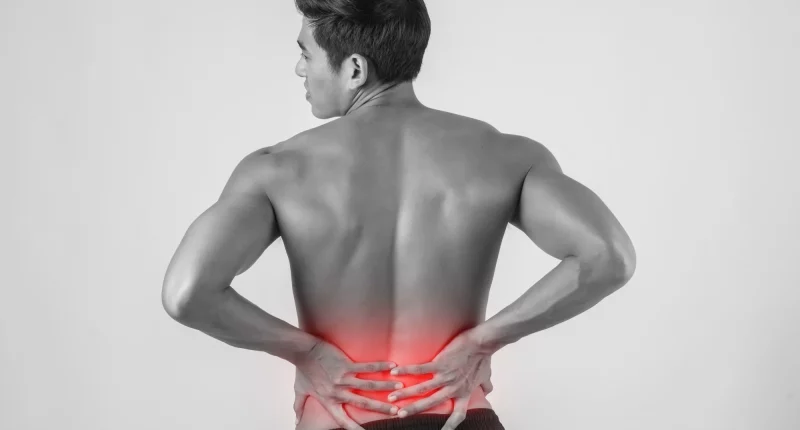Back pain is a common problem that can happen for many reasons. It can be caused by hurting a muscle, damaging a disk in your spine, or having certain health issues like osteoporosis or scoliosis.
There are different ways to treat back pain. You can try using a cold or warm pack on the painful area, acupuncture, or taking medications.
Back pain can be caused by things like getting hurt, doing certain activities, or having certain medical problems. It can happen to anyone, no matter how old they are. As individuals get older, they are more likely to have lower back pain. This could be because of things like the kind of work they did before or have a condition where the disks in their spine break down over time.
When you have lower back pain, it might be because of different things in your body, like problems with the bones in your lower spine, the disks between those bones, the ligaments that hold your spine together, the nerves in your spine, the muscles in your lower back, or even organs in your pelvis or belly.
Sometimes, pain in your upper back can be caused by problems with your aorta (the main blood vessel in your body), tumors in your chest, or inflammation in your spine.
Causes
The back is a complicated part of the body made up of muscles, tendons, ligaments, bones, and disks. They all work together to help us move and support our bodies.
The spine, which is like a stack of bones, has special cushions called disks between each bone. These disks help absorb shock and keep the spine flexible.
Sometimes, problems with any of these parts can cause back pain. But in some cases, it’s hard to know exactly what’s causing the pain.
Back pain can happen for many reasons. It might be because of straining your muscles or ligaments, having a muscle spasm (when a muscle suddenly tightens up), feeling tense in your muscles, or damaging one of the disks in your spine. Injuries, fractures (when a bone breaks), or falling down can also cause back pain.
Some health problems can also cause back pain:
- Cauda Equina Syndrome: This happens when the bundle of nerves at the lower end of your spine gets compressed. It can cause dull pain in your lower back and upper gluteal. You might also feel numbness in your genitals, thighs, and buttocks. Sometimes, it can even affect how your bladder and bowels work.
- Spine Cancer: If there’s a tumor on your spine, it might stress against a nerve and cause back pain. Even the damage to the bone from the tumor can be painful.
- Spine Infections: If you have an infection in your spine, you might have a fever and feel a warm, tender area on your back.
- Other Infections: Conditions like pelvic inflammatory disease or infections in your kidneys or bladder can also make your back hurt.
- Sleep Troubles: People who have trouble sleeping are more likely to have back pain.
- Shingles: This is an infection that can affect your nerves and cause back pain. It depends on which nerves are affected. You might also get a rash along with the back pain.
Symptoms
When you have back pain, the main thing you’ll feel is an ache in your back, and sometimes it might go down to your gluteal and legs.
Sometimes, back problems can make other parts of your body hurt, depending on which nerves are involved.
Usually, the pain goes away on its own without needing any treatment. But if you have back pain along with any of these other things, you should talk to a doctor:
- Losing weight for no reason
- Having a fever
- Seeing swelling or feeling heat in your back
- Having back pain that doesn’t get better when you lie down or rest
- Feeling pain that goes down your legs, especially if it goes below your knees
- Recently getting hurt or having a big hit to your back
- Having trouble controlling your pee (urinary incontinence)
- Finding it hard to pee
- Having trouble controlling your poop (fecal incontinence)
- Feeling numbness around your private parts
- Feeling numbness around your butt
When to consult a doctor
When to contact a doctor depends on various factors related to back pain. If someone experiences tingling or numbness alongside back pain, it’s crucial to seek medical help. This is especially important if the pain persists despite rest or if it occurred after fall or an injury. Additionally, if the back pain is accompanied by numbness in the legs or weakness, it warrants attention from a medical professional. Fever and unexplained loss of weight alongside back pain are also signs that should prompt contacting a specialist for further evaluation and treatment. These symptoms could indicate underlying issues that require medical attention to prevent potential complications and ensure appropriate management of the condition.
Treatment
Treatment for back pain varies depending on its severity and underlying cause. In many cases, rest and home remedies are sufficient to alleviate discomfort, but medical intervention may be necessary in certain situations.
Home treatments typically include over-the-counter pain relief medication, such as nonsteroidal anti-inflammatory drugs (NSAIDs) like ibuprofen, which can help reduce pain and inflammation. Applying hot or cold compresses to the affected area may also provide relief. While rest is important, staying active can help alleviate stiffness and prevent muscle weakness.
If home treatments are ineffective, a doctor may recommend prescription NSAIDs or other medications like muscle relaxants or narcotics for short-term use. Physical therapy can also be beneficial, involving various techniques such as ice, heat, ultrasound scans, and electrical stimulation to alleviate pain and improve flexibility and strength in the back and lower stomach muscles. Cortisone injections or botox injections may be considered if other options fail to provide relief. Traction, cognitive behavioral therapy, and in rare cases, surgery, are additional treatment options for chronic or severe back pain.
Overall, the choice of treatment depends on individual circumstances and should be discussed with a healthcare provider to determine the most appropriate course of action for managing back pain effectively.
Risk factors
Certain things can increase the chances of having lower back pain. These include:
- Work: Some jobs can put a lot of strain on your back, making you more likely to have pain there.
- Pregnancy: Carrying a baby can sometimes cause back pain for women.
- Not Moving Enough: If you spend a lot of time sitting around without moving, it can make your back hurt more.
- Not Enough Exercise: Not getting enough physical activity can weaken your muscles, which might make back pain more likely.
- Getting Older: As people get older, they’re more likely to have back pain.
- Being Overweight: Carrying extra weight can put more stress on your back.
- Smoking: Smoking can affect your circulation and make it harder for your body to heal, which might contribute to back pain.
- Doing Hard Work or Exercise Incorrectly: Doing too much strenuous activity or exercise, especially if you’re not doing it the right way, can strain your back.
- Genes: Sometimes, back pain can run in families.
- Health Problems: Conditions like arthritis or cancer can also make back pain more likely.
Women tend to have lower back pain more often than men, possibly because of differences in hormones. And experts think that anxiety, stress, and mood problems can also be linked to back pain.
Prevention
To lower the chance of developing back pain, it is essential to address various risk factors. Implementing preventive measures can significantly reduce the likelihood of experiencing back issues.
Exercise
Exercising regularly plays a crucial role in building strength and managing body weight. Engaging in low-impact aerobic activities can enhance heart health without causing strain or jolting the back. Before embarking on any exercise program, it is advisable to consult a doctor. To reduce the risk of back pain, individuals can focus on two main kinds of exercise: core-strengthening exercises, which target the back muscles and abdominal to fortify the muscles that protect the back, and flexibility training, which aims to enhance the flexibility of the hips, spine, and upper legs.
Diet
Maintaining a diet rich in vitamin D and calcium is vital for bone health. A balanced diet also aids in managing body weight, which is a significant factor in preventing back pain.
Smoking
There is a notably higher incidence of back pain among individuals who smoke compared to those who do not, even when adjusted for age, weight, and height.
Body Weight
The distribution and amount of body weight significantly affect the chance of growing back pain. Individuals with obesity have a higher chance of experiencing back pain than those with moderate body weight. Additionally, carrying excess weight in the lower stomach area, as opposed to the hip area and buttocks, further increases the risk.
Posture when Standing
To maintain a neutral pelvic position while standing, stand upright with your head facing forward and straight your back. Balance your weight equally on both feet then keep your legs straight, and align your neck with the spine.
Posture when Sitting
For proper sitting posture, especially when working, use a chair that offers armrests, good back support, and a swivel base. Ensure that your hips and knees are level, and make your feet flat on the floor. Sit straight aiding in the small of your back. If using a keyboard, maintain a 90-degree angle between your forearm and upper arm.
Summary
Back pain can stem from muscle strain, disk damage, injuries, or medical conditions like scoliosis and osteoporosis. Home remedies like rest, over-the-counter pain relief, and compresses often help, but medical treatments may be needed for severe cases. Risk factors include certain jobs, pregnancy, lack of exercise, aging, obesity, smoking, strenuous activities, genetics, and health conditions like arthritis.
Women and people with stress or mood disorders are more prone to back pain. Treatments range from medications and physical therapy to injections and, rarely, surgery. Preventative measures and proper techniques can help manage and reduce the risk of back pain.
External links








